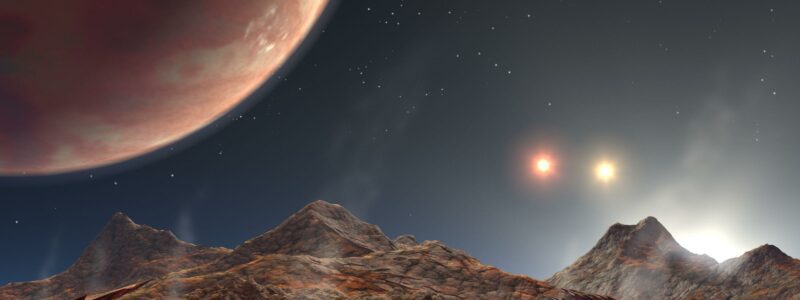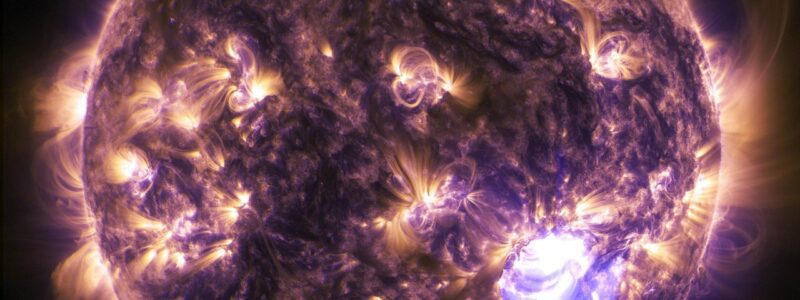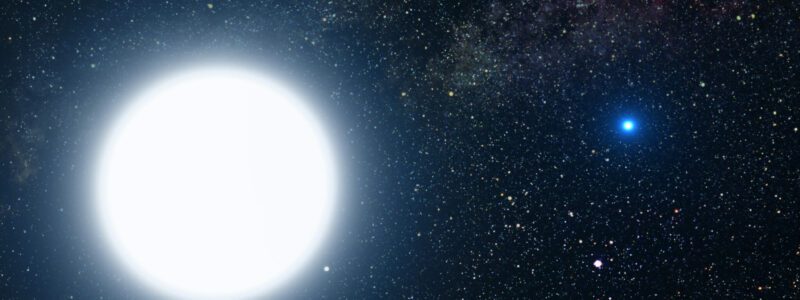Why Mass Matters
Astronomy found that its mass determines nearly every aspect of a star’s physics; in the end, mass matters most. Its mass and lifespan primarily determine the star’s place on the HR diagram. The star’s position on the HR diagram determines its absolute brightness and color.
The problem was that astronomers did not understand why this was so at the beginning of the twentieth century. First, they had thought that maybe younger stars would burn brighter, but this was not necessarily so. Then astronomers hypothesized that larger stars would be brighter, which is also not necessarily so.
The reason why so much physics depends upon the balance between gravity trying to compress the star and thermal pressure from the center of the star attempting to expand it. The center of the star must be hot enough to trigger nuclear reactions to make the star shine and to be stable enough so that the star can shine for millions or even billions of years.
Gravity and Thermal Pressure Desplan Why Mass Matters
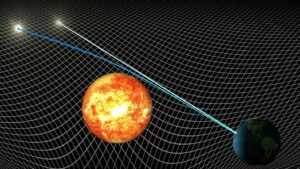
Sun Bending Space-Time
Large clouds of interstellar gas are composed primarily of hydrogen and helium with trace amounts of other elements. These gas clouds have a zero temperature in many areas, but nearby stars heat some gas clouds. The clouds have mass and therefore have a gravitational force that concentrates the mass toward their center. Heat within the gas cloud tends to counter its gravitational force until the cloud reaches an equilibrium. An equilibrium is established when heat expansionary pressure is balanced by gravity contraction pressure.
Some gas clouds are relatively cool, so gravity gradually concentrates the gas into smaller and smaller areas. Initially, the gas cloud does not heat up much, so gravity exerts greater influence. Heat has a more difficult time radiating away from the center of this contracting mass because the concentrated gas becomes less transparent. The concentrated gas then becomes a protostar from which a real star is likely to form.
The heat from a protostar is radiated from the surface as gravity pulls the star’s mass to a smaller volume. As the star gets smaller, it generates more heat in the center. The heat at the surface of the protostar will radiate away while heat becomes trapped in its center. As its surface radiates heat, the forming star cannot generate heat fast enough to counter gravity.
It turns out that the total mass of a protostar will determine whether the protostar can become a star or not. Jupiter is too small to ever form a star. The temperature at the center of Jupiter is just not hot enough to ignite a nuclear reaction. Jupiter has about 0.1% of the mass of the Sun; if it were ten times as massive to about one percent of the Sun’s mass, it could produce a brown dwarf star.
Larger Protostars Turn Into Stars
The increasing heat at the center of a protostar will eventually reach the amount necessary to cause nuclear fusion to begin if it is massive enough. At this point, the protostar will become a real star as hydrogen fuses into helium, releasing tremendous amounts of energy. At this point, the star will likely expand due to the immense heat from fusion. Gravitational force and heat reach a new equilibrium lasting millions, if not billions of years. The star develops a stable core temperature fusing hydrogen into helium, constant surface temperature, luminosity, and color. It is now a main sequence “dwarf” star and will main in this state for as long as conditions in which the balance between gravity and heat continue.
For a protostar to turn into an actual star, it needs to have enough mass so that the gravitational pull inward will heat its core to a high enough temperature for fusion to occur. The protostar needs at least 8 percent of the sun’s mass for this to happen. Otherwise, it will never generate enough heat for a nuclear fusion proton-proton chain reaction.
A Brown Dwarf Star
Smaller protostars follow another parkway. They are about 1 – 8 percent of the sun’s mass and are not big enough to generate enough pressure and heat for hydrogen fusion into helium. Instead, they will fuse deuterium into helium, producing something called a “brown dwarf” star. One of every 6000 hydrogen atoms has a nucleus with both a proton and a neutron. This kind of hydrogen with an extra neutron is called “deuterium.” The usual hydrogen atom only has a proton in its nucleus with no neutron. As a result, brown dwarf stars have very little fuel available for nuclear reactions. Even the most massive brown dwarfs have only enough to last about 100 million years, then flicker out.
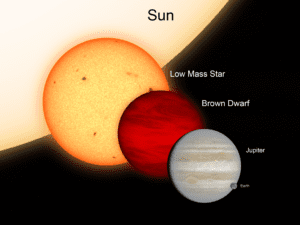
By Planetkid32 – Own work, CC BY-SA 4.0, Link
Newly formed protostars are dim and are located far to the right and lower on the HR diagram. As the protostar continuously warms, they move from the right to left and gradually assume their position on the HR diagram.
Eddington was the first to discover the mass-luminosity relationship in the 1920s and explained why the main sequence of the HR diagram is a “mass sequence.” This is because the most massive stars are also the brightest as the temperature in the core is greater – they are the most massive and the hottest.
The Death of a Star
A star can not continue burning hydrogen forever; gradually, its hydrogen store gets used up. Larger mass stars convert hydrogen to helium at a much greater rate and have much shorter lifetimes. For example, a ten solar mass star will use up unspent hydrogen at its core in about 30 million years.
A 50-solar mass star shines bright on the HR diagram for only about 0.5 million years – just a flash in the night compared to the universe’s age.
After the hydrogen in the core of a star is depleted, the proton-proton fusion reactions will decrease, and the star will not be able to replace the heat that escapes from its surface. As a result, gravity will win out over temperature, and the star will begin to shrink.
But it is not yet out of tricks – it can get another life as another kind of star.
Summary
Stars may look the same to the unaided eye. Some of them are a little brighter, while others are nearly invisible. Many more stars are visible using a pair of binoculars, and many more require the use of a telescope.
The reason why stars look different at night has been a mystery since antiquity. Some thought stars all have the same intrinsic brightness, with the dimmer appearing stars just more distant. Others opined all stars were the same distance and were attached to a “celestial sphere,” with stars having different intrinsic brightness.
These were conjectures based on philosophical principles and not on science. In the past few hundred years, the mysteries surrounding how stars are made, their composition, and what causes them to shine have become known.
This knowledge will help determine the universe’s age since we can now determine the age of individual stars. More to come!

